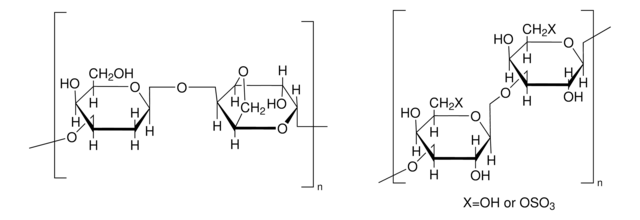56763
Agar
high purity, low ionic content, low gel strenght, suitable for microbiology
Synonym(s):
Agar-agar, Gum agar, Agar-agar, Gum agar
About This Item
Recommended Products
Quality Level
sterility
non-sterile
form
powder
shelf life
limited shelf life, expiry date on the label
ign. residue
≤4.0%
loss
≤10% loss on drying
turbidity
≤8 NTU (after autoclaving)
mp
85-95 °C
transition temp
gel point 34-36 °C
gel strength
≥800 g/cm2
anion traces
sulfate (SO42-): ≤2.75%
cation traces
Ca: ≤500 mg/kg
Mg: ≤200 mg/kg
application(s)
microbiology
InChI
1S/C14H24O9/c1-5-8(16)13-11(7(21-5)4-20-13)23-14-10(18)12(19-2)9(17)6(3-15)22-14/h5-18H,3-4H2,1-2H3/t5?,6-,7?,8-,9+,10-,11?,12+,13+,14?/m1/s1
InChI key
GYYDPBCUIJTIBM-DYOGSRDZSA-N
Looking for similar products? Visit Product Comparison Guide
Related Categories
General description
Application
Analysis Note
wgk_germany
WGK 1
flash_point_f
Not applicable
flash_point_c
Not applicable
Choose from one of the most recent versions:
Already Own This Product?
Find documentation for the products that you have recently purchased in the Document Library.
Customers Also Viewed
Articles
Culture media provides a habitat with suitable nutrients, energy sources, and certain environmental conditions for the growth of microorganisms. The components of the culture media range from simple sugars to peptones, salts, antibiotics, and complex indicators.
Our team of scientists has experience in all areas of research including Life Science, Material Science, Chemical Synthesis, Chromatography, Analytical and many others.
Contact Technical Service

